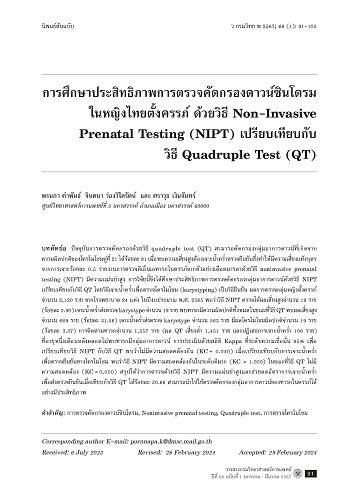A Comparative Assessment of Non-Invasive Prenatal Testing (NIPT) and Quadruple Test (QT) for the Detection of Down Syndrome in Pregnant Thai Women
Performance of NIPT for Detection of Down Syndrome Compared with QT
Keywords:
Down syndrome screening, Noninvasive prenatal testing, Quadruple test, KaryotypingAbstract
Currently, screening using the quadruple test (QT) method can detect Down syndrome, a genetic disease resulting from abnormalities in chromosome 21, at a rate of 81%. Upon detecting high-risk results, amniocentesis confirmation is required, posing a risk of miscarriage at 0.5%. From the literature review, there were reports on the efficacy of noninvasive prenatal testing (NIPT) in detecting fetal abnormalities from maternal blood samples. The objective of this research was to investigate the screening performance of NIPT compared to the QT method, using amniocentesis for karyotyping as the confirmation. The study involved 2,120 pregnant women from 24 hospitals in the fiscal year 2022. It was found that NIPT identified 19 high-risk cases (0.90%), all of which were confirmed for chromosomal abnormalities by karyotyping. In contrast, the QT method identified 669 high-risk cases (31.56%), with 19 out of 563 cases (3.37%) confirmed for chromosomal abnormalities by karyotyping. Follow-up of 1,557 infants (1,451 classified as low-risk by QT and 106 who declined amniocentesis) at one-month-old revealed no cases of Down syndrome. Statistical assessment using Kappa at a 95% confidence level to compare NIPT and QT methods showed poor agreement (KC = 0.040) compared to karyotyping confirmation. However, NIPT demonstrated excellent agreement (KC = 1.000) with karyotyping, while QT showed no agreement (KC = 0.000). In summary, NIPT screening exhibited high accuracy and reduced the rate of amniocentesis for confi rmation by 30.66% compared to the QT method, making it an effective tool for screening fetal Down syndrome.
References
เฟื่องลดา ทองประเสริฐ. การตรวจคัดกรองการตั้งครรภ์ทารกกลุ่มอาการดาวน์ (Down syndrome screening). [ออนไลน์].2554; [สืบค้น 28 ต.ค. 2564]; [32 หน้า]. เข้าถึงได้ที่: URL:https://w1.med.cmu.ac.th/obgyn/lecturestopics/residents-fellows/1757.
Wasant P, Kamolsilp M. The study of birth defects in the newborns at Siriraj Hospital (1990-1991). Siriraj Hosp Gaz 1993; 45(11): 749-58.
พิศพรรณ วีระยิ่งยง, จอมขวัญ โยธาสมุทร, ศรวณีย์ ทนุชิต, ศุภวรรธน์ เพิ่มผลสุข, สุธีนุช ตั้งสถิตย์กุลชัย, ณัฐธิดา มาลาทอง, และคณะ. รายงานฉบับสมบูรณ์การประเมินโครงการนำร่องการป้องกันและควบคุมกลุ่มอาการดาวน์ (โครงการประเมินเทคโนโลยีและนโยบายด้านสุขภาพ). นนทบุรี: สถาบันวิจัยระบบสาธารณสุข; 2559.
พีระยุทธ สานุกูล. การตรวจคัดกรองทารกกลุ่มอาการดาวน์โดยวิธี Quadruple Marker Test. ว. ศูนย์อนามัยที่ 7 ขอนแก่น 2561; 10(1): 1-11.
ศูนย์อนามัยที่ 7 ขอนแก่น กรมอนามัย. โครงการป้องกันการเกิดทารกกลุ่มอาการดาวน์ เขตสุขภาพที่ 7 ปีงบประมาณ 2562. [ออนไลน์]. 2562; [สืบค้น 25 ต.ค. 2564]; [27 หน้า]. เข้าถึงได้ที่: URL: http://203.157.71.148/data/cluster/mom/download/Down62.pdf.
คณะอนุกรรมการอนามัยแม่และเด็ก พ.ศ. 2556-2558, คณะอนุกรรมการมาตรฐานวิชาชีพ พ.ศ. 2556-2558. แนวทางเวชปฏิบัติของราชวิทยาลัยสูตินรีแพทย์แห่งประเทศไทย เรื่องการตรวจคัดกรองทารกกลุ่มอาการดาวน์ในสตรีตั้งครรภ์. กรุงเทพฯ: ราชวิทยาลัยสูตินรีแพทย์แห่งประเทศไทย; 2557.
คณะกรรมการจัดทำคู่มือปฏิบัติงานการตรวจวินิจฉัยกลุ่มอาการดาวน์ในหญิงตั้งครรภ์ทางห้องปฏิบัติการ. คู่มือการตรวจทางห้องปฏิบัติการกลุ่มอาการดาวน์ในหญิงตั้งครรภ์. นนทบุรี: กรมวิทยาศาสตร์การแพทย์ กระทรวงสาธารณสุข; 2562. หน้า 8-18.
Wright CF, Burton H. The use of cell-free fetal nucleic acids in maternal blood for non-invasive prenatal diagnosis. Hum Reprod Update 2009; 15(1): 139-51.
Allyse M, Minear MA, Berson E, Sridhar S, Rote M, Hung A, et al. Non-invasive prenatal testing: a review of international implementation and challenges. Int J Womens Health 2015; 7: 113-26.
Dahl F, Ericsson O, Karlberg O, Karlsson F, Howell M, Persson F, et al. Imaging single DNA molecules for high precision NIPT. Sci Rep 2018; 8(1): 4549. (8 pages).
DELFIA time-resolved fluorescence assays. [online]; [cited 2021 Oct 15]. Available from: URL: https://www.perkinelmer.com/th/labproducts-and-services/application-supportknowledgebase/delfia/delfia-trf-assays.html#DELFIAtime-resolvedfluorescenceassays-Assayprinciple.
Vanadis® NIPT system noninvasive prenatal testing. [online]; [cited 2021 Oct 15]; [8 screens]. Available from: URL: https://resources.perkinelmer.com/lab-solutions/resources/docs/bro_vanadis_labbrochure.pdf.
Landis JR, Koch GG. The measurement of observer agreement for categorical data. Biometrics 1977; 33(1): 159-74.
Lamb NE, Freeman SB, Savage-Austin A, Pettay D, Taft L, Hersey J, et al. Susceptible chiasmate configurations of chromosome 21 predispose to non-disjunction in both maternal meiosis I and meiosis II. Nat Genet 1996; 14(4): 400-5.
Morris JK. Commentary: clustering in Down syndrome. Int J Epidemiol 2008; 37(5): 1179-80.
Capalbo A, Hoff mann ER, Cimadomo D, Ubaldi FM, Rienzi L. Human female meiosis revised: new insights into the mechanisms of chromosome segregation and aneuploidies from advanced genomics and time-lapse imaging. Hum Reprod Update 2017; 23(6): 706-22.
Sperling K, Scherb H, Neitzel H. Population monitoring of trisomy 21: problems and approaches. Mol Cytogenet 2023; 16: 6. (12 pages).
Zhang H, Gao Y, Jiang F, Fu M, Yuan Y, Guo Y, et al. Non-invasive prenatal testing for trisomies 21, 18 and 13: clinical experience from 146,958 pregnancies. Ultrasound Obstet Gynecol 2015; 45(5): 530-8.
Hartwig TS, Ambye L, Sørensen S, Jørgensen FS. Discordant non-invasive prenatal testing (NIPT) - a systematic review. Prenat Diagn 2017; 37(6): 527-39.
Dai R, Yu Y, Zhang H, Li L, Jiang Y, Liu R, et al. Analysis of 17,428 pregnant women undergoing non-invasive prenatal testing for fetal chromosome in Northeast China. Medicine 2021; 100(6): e24740. (6 pages).
Grati FR, Malvestiti F, Ferreira JC, Bajaj K, Gaetani E, Agrati C, et al. Fetoplacental mosaicism: potential implications for false-positive and false-negative noninvasive prenatal screening results. Genet Med 2014; 16(8): 620-4.
Boon EM, Faas BH. Benefits and limitations of whole genome versus targeted approaches for noninvasive prenatal testing for fetal aneuploidies. Prenat Diagn 2013; 33(6): 563-8.
Yaron Y. The implications of non-invasive prenatal testing failures: a review of an under-discussed phenomenon. Prenat Diagn 2016; 36(5): 391-6.
Canick JA, Palomaki GE, Kloza EM, Lambert- Messerlian GM, Haddow JE. The impact of maternal plasma DNA fetal fraction on next generation sequencing tests for common fetal aneuploidies. Prenat Diagn 2013; 33(7): 667-74.
Fiorentino F, Bono S, Pizzuti F, Mariano M, Polverari A, Duca S, et al. The importance of determining the limit of detection of non invasive prenatal testing methods. Prenat Diagn 2016; 36(4): 304-11.
Guy GP, Hargrave J, Dunn R, Price K, Short J, Thilaganathan B. Secondary non-invasive prenatal screening for fetal trisomy: an effectiveness study in a public health setting. BJOG 2021; 128(2): 440-46.
Pooh RK, Masuda C, Matsushika R, Machida M, Nakamura T, Takeda M, et al. Clinical validation of fetal cfDNA analysis using rolling circle-replication and imaging technology in Osaka (CRITO Study). Diagnostics 2021; 11(10): 1837. (22 pages).

Downloads
Published
How to Cite
Issue
Section
License
Copyright (c) 2024 BULLETIN OF THE DEPARTMENT OF MEDICAL SCIENCES

This work is licensed under a Creative Commons Attribution-NonCommercial-NoDerivatives 4.0 International License.



